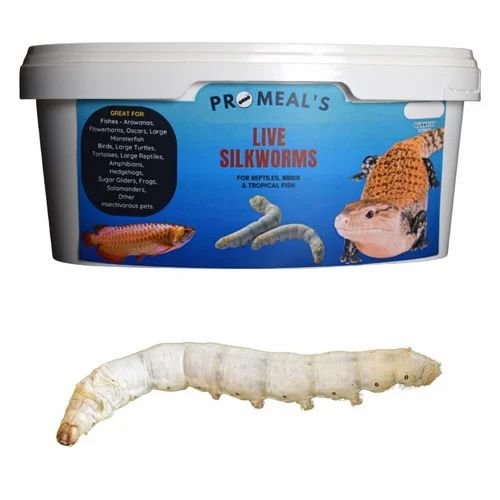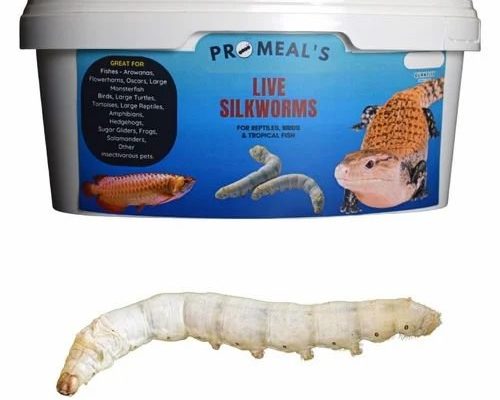
Silkworms are actually the larvae of the *Bombyx mori* moth and are often used in various cultures for food, not just for pets. They’re known for their soft texture and mild flavor, making them an appealing option for fish and reptiles. So, if you’re open to exploring new feeding avenues, let’s dive into why silkworms may be the perfect addition to your pet’s menu.
What Are Silkworms?
Silkworms are the caterpillar stage of the *Bombyx mori* moth, primarily raised for their silk. However, they also serve as an excellent food source. These larvae are typically white and soft, unlike many other insects, which tend to have a hard exoskeleton. This makes them easier for reptiles and fish to digest.
Silkworms are often sold in various forms: live, dried, or freeze-dried. Each option has its pros and cons. For instance, live silkworms are highly nutritious, but they require specific care to keep them alive. On the other hand, dried or freeze-dried versions are more convenient and have a longer shelf life.
Many pet owners are discovering the benefits of incorporating silkworms into their pets’ diets. They are high in protein, rich in vitamins and minerals, and provide a unique taste that pets often love. Honestly, who wouldn’t want to give their little friends a gourmet treat?
Nutritional Benefits of Silkworms
When it comes to nutrition, silkworms really shine. They are packed with protein, which is essential for growth, muscle development, and maintaining a robust immune system. In fact, silkworms can contain up to 50% protein by weight, making them an excellent food source for both reptiles and fish who need that extra boost.
These larvae also boast a good amount of **amino acids**, which are the building blocks of proteins. Amino acids are crucial for many bodily functions, from muscle repair to hormone production. If you’re feeding your pets silkworms, you’re not just filling their bellies; you’re providing them with the tools they need to thrive.
Additionally, silkworms are rich in vitamins like **B2** (riboflavin) and **B3** (niacin). These vitamins play vital roles in energy production and metabolism. By including silkworms in your pet’s diet, you can help ensure they receive a well-rounded meal that supports their overall health.
How to Feed Silkworms to Your Reptiles
Feeding silkworms to reptiles can be straightforward, but there are a few steps to keep in mind to make sure your pets enjoy their new treat. First off, you want to ensure the silkworms are the right size for your reptile. Larger reptiles can handle bigger worms, while smaller ones might need younger, smaller silkworms.
Here’s a simple process to follow:
- Choose the Right Size: Ensure the silkworms fit comfortably in your reptile’s mouth.
- Preparation: If you’re using live silkworms, you can simply drop them into the enclosure. For dried or freeze-dried options, you might want to moisten them slightly to make them more appealing.
- Introduce Slowly: If your reptile is new to silkworms, start with a small amount. Observe how they respond before making it a regular part of their diet.
- Monitor Feeding: Keep an eye on the feeding process. Some reptiles might take to silkworms quickly, while others may need a bit of encouragement.
You might be wondering how often you should feed them. Silkworms can be a regular treat, but balance is essential. They shouldn’t replace a complete diet but can be offered a few times a week as a supplement.
Feeding Silkworms to Fish
Switching gears, let’s talk about fish. Silkworms can also be an excellent choice for aquatic pets. Like reptiles, fish require a balanced diet, and silkworms can help achieve that. They can be especially beneficial for carnivorous fish that thrive on protein-rich diets.
Here’s how to feed silkworms to your fish:
- Live vs. Dried: Live silkworms can be fun to watch as they swim in the tank. However, dried options are often easier to manage and store.
- Drop and Observe: Simply drop the silkworms into the tank and watch your fish interact with them. They’ll likely go for them quickly, enjoying the added protein boost.
- Portion Control: Be mindful not to overfeed; fish can be greedy. Remove any uneaten silkworms after a few minutes to prevent water quality issues.
Silkworms can be a fantastic treat, but they should complement a varied diet. Pairing them with high-quality pellets or flakes can give your fish a well-rounded meal.
Potential Concerns with Feeding Silkworms
While silkworms are a great addition to many pets’ diets, there are a few things to watch out for. First, always source your silkworms from reputable suppliers to ensure they’re safe and healthy. Feeding wild-caught insects can introduce parasites and diseases that could harm your pets.
Another concern is the fat content. Silkworms are higher in fat than many other insects, so it’s essential to offer them in moderation. Too much fat can lead to obesity in reptiles and fish, which can cause various health issues in the long run.
Finally, if your pets have any specific dietary restrictions or health concerns, consult with a veterinarian before introducing silkworms into their diet. Every pet is unique, and what works for one may not work for another.
Alternatives to Silkworms
If you’re considering other options alongside silkworms, there are plenty of alternative insects that can also provide great nutrition for reptiles and fish. Here are a few popular choices:
- Crickets: Widely available and a staple for many reptiles.
- Mealworms: Easy to digest and provide a good source of protein.
- Waxworms: High in fat, they’re more of an occasional treat rather than a staple food.
- Butterworms: Another excellent option with a unique flavor that many pets love.
Using a mix of these insects can help keep your pet’s diet varied and interesting. You might find that your pets have specific favorites, which can turn mealtime into an exciting adventure!
Feeding your reptiles and fish silkworms might seem unconventional, but it can lead to some fantastic health benefits. They’re nutritious, easy to digest, and offer a different texture and flavor that many pets enjoy. Incorporating silkworms into your pets’ diets doesn’t mean you have to ditch their usual food; think of it as a delightful treat that enhances their meal plan.
Ultimately, the key is to provide your pets with a balanced diet that fuels their energy and keeps them healthy. So, why not give silkworms a try? You might just discover a new favorite for your scaly or aquatic companions.

